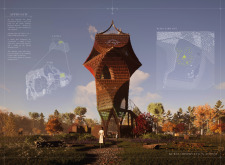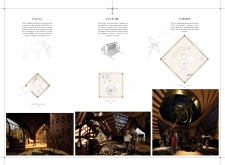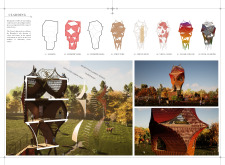5 key facts about this project
The Kurgi Observation Tower is situated in the North Vidzeme Biosphere Reserve, known for its rich and varied natural landscapes. The design aims to create a relationship between the structure and the surrounding environment. It serves both educational and community purposes, allowing visitors to engage with local heritage and biodiversity. The concept revolves around two key components: The Tower and The Podium, creating a space that invites exploration and connection to nature.
Design Configuration
The layout features The Podium as the first point of entry, characterized by locally-sourced rammed earth walls. These walls provide both functional and aesthetic benefits. The use of modular, reusable shuttering allows for varied wall depths, which enhances acoustics and visual complexity. This choice reflects a commitment to sustainability and a respect for local building techniques.
Educational Focus
At the heart of the design lies an amphitheater integrated into the earth. This space serves as a venue for presentations and community events. The design encourages social connection and learning. A campfire adds warmth and comfort, making it an inviting area for gatherings. This emphasis on interaction highlights the role of community in environmental education.
Cultural Engagement
As visitors move up to The Tower, they discover spaces dedicated to local wildlife and cultural significance. The second level features an exhibit focused on the importance of horses in Latvian culture and ecology. A horse skeleton provides a tangible connection to the region's biological history. This aspect fosters a deeper understanding of the local ecosystem and how it relates to cultural identity.
Artistic Integration
The third level showcases Latvia's weaving traditions through the presence of a loom. This area not only provides a place for creative expression but also connects visitors to the region’s craft heritage. Decorated with completed weaves that change over time, this design element emphasizes the relationship between cultural practices and architectural space.
At the top level, the observation deck offers wide-ranging views of the surrounding biosphere. A telescope invites visitors to explore beyond the immediate landscape, encouraging curiosity about both nature and the universe. The design enhances the connection between the visitors and the environment, creating a space for reflection and discovery.






















































